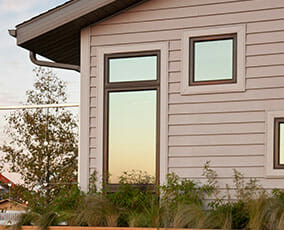Vinyl siding has become a staple in modern construction, adorning homes, and buildings with its sleek and durable exterior. The siding option is a popular choice for modern construction due to its superb features that homeowners love. The material is durable, has low maintenance requirements, and provides aesthetic appeal.
But over the years, due to rising environmental concerns, homeowners now seek other siding materials, such as ones that are sustainable and don’t have as much of an impact on nature. Due to this increased attention, the need to recycle building materials, including vinyl siding, has become a pressing issue.
In this blog post, we’ll explore the question of whether you can recycle vinyl siding, and examine the recycling process, the environmental impact of vinyl siding, and the challenges associated with vinyl recycling. But before getting to the core of the question, let’s start with what vinyl siding is.
What Is Vinyl Siding?
Vinyl siding is a type of plastic siding material used to cover the exterior walls of homes and other structures. It is made from polyvinyl chloride (PVC), a thermoplastic material that is derived from natural gas and salt. The manufacturing process involves blending PVC with various additives to enhance its durability, flexibility, and resistance to UV radiation.
One of the primary advantages of vinyl siding is its low maintenance requirements. Unlike traditional building materials like wood or stucco, vinyl siding does not require painting or staining and can be easily cleaned with soap and water. It is also highly resistant to moisture and insect infestations and is available in a variety of siding colors for you to choose from.
When And How Does Vinyl Siding Become Damaged?
Vinyl siding is generally a durable and low-maintenance siding option, but it is not indestructible and can become damaged under certain circumstances. Here are some examples of when your vinyl siding may be susceptible to damage, and you may need to consider replacing it.
Impact Damage:
Vinyl siding is a relatively durable and low-maintenance option for homes, but it can still be damaged under certain circumstances. For example, if it is hit with enough force from a falling tree limb or a projectile during a storm, it can dent or crack. Additionally, children playing near the siding of a home may accidentally cause damage by hitting it with hard objects.
Age:
While vinyl siding is generally a long-lasting and durable option, its lifespan can vary depending on the quality of the material and the installation. Most vinyl siding products are designed to last around 20 to 40 years, but factors such as exposure to harsh weather conditions, poor installation, or lack of maintenance can shorten the lifespan. Over time, exposure to the elements, UV radiation, and normal wear and tear cause you to replace your vinyl siding.
Pest Infestation:
Your vinyl siding can become damaged by pest attacks and other tiny animals. While vinyl siding is generally resistant to pest damage, some pests still try to chew or scratch their way through the material.
Recycling Vinyl Siding: What You Need To Know
Vinyl is a synthetic, PVC-based siding material. Now you might be thinking, how can a plastic material be recycled? Well, the truth is, you can recycle vinyl siding, but it is not as simple as it seems, and various factors can affect the vinyl siding recycling process.
Unlike other regular plastics, which cannot be recycled or else they take too much time to decompose, vinyl is slightly different as it is a thermoplastic that can be recycled for other uses. In fact, vinyl siding is one of the few vinyl-based products that can actually help with environmental sustainability.
Over the years, the manufacturing process of vinyl siding has seen drastic improvements, and the leading vinyl siding manufacturers are promoting sustainable siding options. Most companies now claim that they do not produce any waste during the siding manufacturing process.
While not biodegradable, you can recycle vinyl siding and turn it into new products. However, the recycling process for PVC can be complicated and requires specialized equipment and expertise. Additionally, not all recycling facilities are equipped to handle PVC, which can limit the number of recycling options. But efforts are constantly being made to increase the facility’s ability to process PVC, and make siding even more sustainable, so as a homeowner, you can trust you’re not only getting a durable and affordable option but an environmentally friendly one too.
In conclusion, recycled vinyl siding is a real thing, but the process is complex and may not be widely available in all areas. As such, it’s important to consider the environmental impact of vinyl siding before purchasing it for your home.
What Does the BEES Report Say?
BEES stands for Building for Environmental and Economic Sustainability. It is a popular software application made by the National Institute of Standards and Technology (NIST).
This software works to assess the lifecycle and the environmental impact of building products, sidings being one of them.
According to this report, contrary to the general opinion, vinyl siding has a lower environmental impact than other popular siding materials used in the United States, such as brick siding. Other findings in this report state that the manufacturing of vinyl siding produces almost no waste, and the production process emits considerably lower levels of toxins compared to other siding options.
Popular Brands That Manufacture Eco-Friendly Vinyl Siding
There are several brands that manufacture eco-friendly vinyl siding options, some of which include:
CertainTeed:
CertainTeed is a leading manufacturer of building materials, including vinyl siding. They offer a range of sustainable vinyl siding options, including products made with recycled materials and low-emission materials.
The company claims to use almost 100% of the raw material needed for its Cedar Impressions Siding line along with its other vinyl siding products. CertainTeed also has a program in which it buys back post-consumer siding from the builder in order to use it in other types of products.

Ply Gem:
Ply Gem offers a range of eco-friendly vinyl siding options, including products made with recycled content and sustainable manufacturing practices. Their products are also designed to be energy-efficient, helping to reduce the environmental impact of a home.
Ply Gem has implemented an extensive recycling program in all of its plants, which enables manufacturing facilities to recycle 95% or more of scrap vinyl. Additionally, the company utilizes up to 80% reclaimed materials in some of its siding products.
If you want to know more about other popular brands that manufacture vinyl siding, then check out our blog post on which vinyl siding brands made the cut in 2022.

Get the Best Quality Vinyl Siding Installation Service In Tulsa
Now that you know the answer to whether or not vinyl siding is recyclable, the next step is to find a trusted and reputable siding installation company to ensure that the siding is installed perfectly on your exterior.
At A. Fricker Roofing and Waterproofing we specialize in vinyl siding installation and offer a range of eco-friendly options to suit your needs and preferences. Our team of experts can work with you to choose the right style and color of vinyl siding to complement your home’s architecture and design. Contact us today, at (918) 402-7167 to schedule a consultation, and get started on transforming the look of your home with new vinyl siding.

